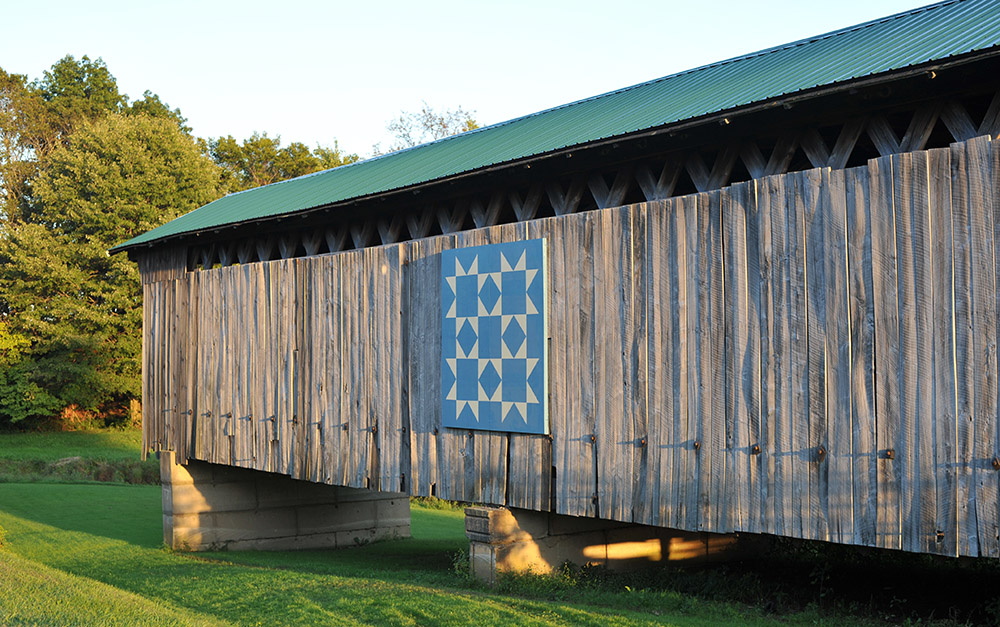
Location:
Graham Road, Pierpont Township.
From Route 11, exit on Route 167, head east. Take Stanhope Kelloggsville north to Graham Road. Turn east to bridge, on right.
Date of Construction:
1913 at the site to the east, where a newer bridge spans this branch of the Ashtabula River.
Relocation:
Moved in 1971. The bridge is the center piece of a metro park.
Style:
Town lattice with metal roof (roof replaced in 2014).
Date of Construction:
Length: 97 feet.
Narrative (from “The Covered Bridges of Ashtabula County,” by Carl E. Feather:
This Town lattice bridge is the only covered bridge in Ashtabula County not open to traffic. It rests on a foundation built by the Ashtabula County Engineer’s Office in a field near the bridge’s original site on Graham Road. The bridge is the centerpiece of an Ashtabula County Metropark.
This little bridge did a great deal of traveling in its lifetime. At the time of the 1913 flood, the bridge spanned the Grand River at Callender Road in Rome Township. The flood washed out the structure, was carried a mile downstream. The timbers were collected and hauled to Pierpont Township, where a bridge was needed to span the East Branch of the Ashtabula River.
It was at that point in the story that Robert Benson’s family got involved in the bridge’s history. Robert’s house overlooks the crossing and, since the early 1970s, he has been the relocated bridge’s neighbor.
His grandfather, Albert “A.D.” Benson got the job of assembling the recycled bridge at its new location. Albert was assisted by his son-in-law, Herb Munger, who had a sawmill and sawed the red beech planks for the flooring. He was paid $26 per 1,000 feet of lumber, sawed 2.5 inches thick and in 16-inch planks.
“That made up the width of the bridge, just room for two horse and buggies to meet,” Herb Munger said in a 1971 newspaper interview.
Herb also had the task of making the trennels for the Town lattice members. Each pin measured 8 inches long and was 1.25 inches wide. He used oak or hickory, which was cut into blocks 8 inches long. The blocks were driven through an iron throw to create the round shape.
Robert Benson, who was born in 1922, says his grandfather died when he was very young, but he heard from family how A.D. ran into difficulty re-assembling the structure. He says an old bridge builder was called in to assist, and pointed out that they were attempting to assemble the timbers upside down.
Robert, who has lived on Graham Road since the late 1940s, said the bridge was never strong enough to carry the loads farmers needed to haul across the stream. Back when he was a boy, there was a gravel pit operation near Route 7. If a team pulling a wagon full of gravel had to cross the stream, it would descend the hill on a spur and ford the East Branch rather than risk crossing the bridge with the heavy load.
He recalls the county testing the bridge’s mettle annually and then posting the weight limit. The test was conducted with a dump truck loaded with stone and slowly driven across the old bridge.
“They’d watch and see how much the bridge sagged,” Robert says.
By 1970 the old bridge was seriously antiquated and pegged for replacement. John Smolen, who was the county’s bridge engineer at the time, says the bridge suffered damage when a vehicle that was too tall for the portal attempted to enter it. An insurance settlement from that incident helped fund the relocation.
“It was weak,” Robert says of the covered bridge. “It was so restricted, they had to restrict the height (of traffic entering it) with steel beams. It was under eight feet. Farmers were complaining about it.”
The options were to move, burn or re-route it, not a practical solution. Bob and his wife Helen didn’t want to see it burned, so they offered to donate a portion of their land so the bridge would have a new home near it’s the former crossing.
In the summer of 1971 cribbing was built under the bridge, which was raised onto rails and rollers. The bridge was rolled off its embankments and then moved to the new site using house-moving carts. The county laid eight pre-stressed beams 66-feet in length for the bridge’s new foundation. Several years later, the bridge was rehabilitated by the county. The new siding and roof gave the old bridge a new lease on life as a picnic shelter and tourist attraction.
Because it is closed to traffic, a number of weddings have been held in this bridge, including a New Year’s Day ceremony when the temperature was around zero. Bob assists with events at the bridge by running a power cord to the structure if electricity is needed. He also keeps the grass mowed and watches out for vandalism and other mishaps.
“There was a fellow who parked up on top of the hill and pulled in so his truck was facing the bridge,” Robert says. “He didn’t put the truck in gear and it rolled down the hill and hit the abutment (of the new bridge).”

